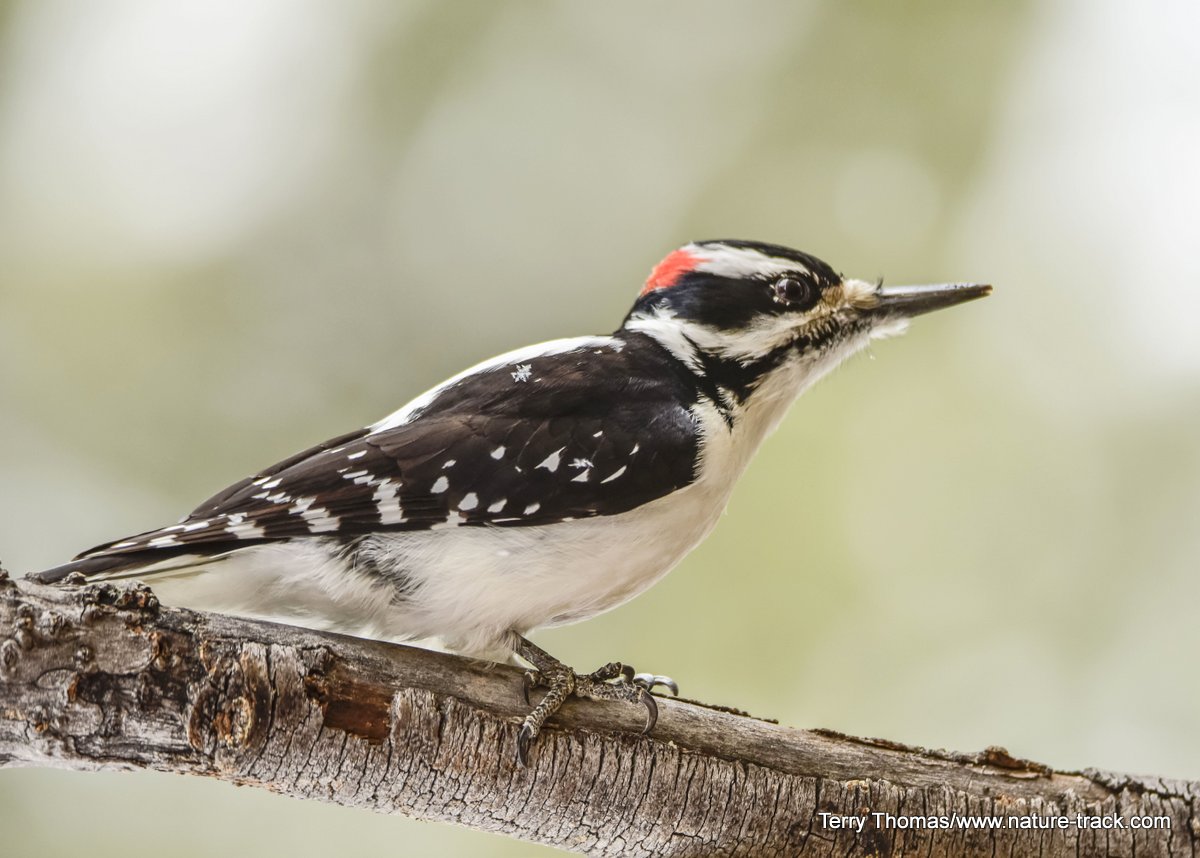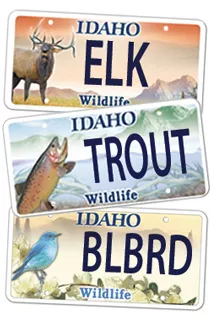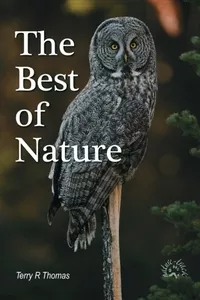Hairy Woodpecker

The bill on this male hairy woodpecker is approximately as long as the rest of the head, a simple way to distinguish a hairy from a downy woodpecker
I scattered a few peanuts on the picnic table on our deck and it did not take long before half a dozen species were lining up for a freebie. One of those species was a hairy woodpecker, a favorites of ours partly because they are common and easy to see.
Now, birds do not have hair, so what is up with the name of this woodpecker? It is named for a patch of long thread-like white feathers in the middle of its back. Not really hair, but the point is made.
Hairy woodpeckers are about the size of a red-winged blackbird and are black and white. The male adds a bit of red to the back of its head. This bird is widespread, ranging from central Alaska to Central America and from the east to the west coast. They can be found in all 48 states and 10 Canadian provinces. Their habitat reaches from sea-level to high mountain forest.
With such a wide distribution, it is expected that plumage will be quite variable, and indeed, there are currently 17 subspecies which may vary dramatically in pattern and size. For instance, eastern hairy woodpeckers have a more spotted wing than western subspecies.
In researching this bird, I found it interesting that there seems to be disagreement on just exactly where the genus belongs. I found three different scientific names: Dryobates villosus, Leuconotopicus villosus and Picoides villosus. It would appear that the Picoides moniker has mostly fallen out of favor and Dryobates leads, so that is what I have settled on: Dryobates villosus.
There are two species in our area that can be confused with the hairy woodpecker. The first is the downy woodpecker which is almost a twin to the hairy except in size: the downy woodpecker isn’t much larger than a house sparrow and has a smaller bill. A good rule-of-thumb when the two are not together to compare sizes is to look at the bill. The hairy woodpecker’s bill is almost as long as the rest of its head (from the back of the head to the bill). With the downy woodpecker, the bill is shorter than the rest of the head.
There is one behavioral clue as well. Hairy woodpeckers tend to work the trunks of the trees. Downy woodpeckers will often work out onto the smaller branches.
The other black and white woodpecker in our area is the yellow-bellied sapsucker. If you are looking at a male sapsucker, it will have a large red patch on the nape and also a red throat. However, females don’t have this, so look for a white patch on the wing. If it is there, it is a sapsucker not a hairy woodpecker.
Hairy woodpeckers are easy to attract to bird feeding stations using peanuts and or suet blocks. Both are favorites of these birds, especially in the winter. Suet will keep them around until the suet is gone.
However, about 75 percent of a hairy woodpecker’s diet is insect larva, especially woodboring beetles and bark beetles. When populations of beetles are up following a fire or a series of warm winters that favor overwinter beetle larva survival, hairy woodpeckers respond by producing more young that survive to adulthood. That makes them important in helping to maintain a balanced environment.
Hairy woodpeckers are one of those species lucky enough to have actually increased slightly between 1966 and 2019. I doubt humans can take much credit for that, it is likely more of a testament to the adaptability of this particular bird.
Hairy woodpeckers, and the chance to see them often, are one of the joys of winter. I am glad to have them back in my life for a while.
Help Idaho Wildlife
When we traveled across the state in October 2017, most of the vehicles we saw using the wildlife management areas did not have wildlife plates. Buying wildlife plates is a great way for non-hunters and hunters alike to support wildlife-based recreation like birding.
C'mon folks, let's help Idaho's wildlife by proudly buying and displaying a wildlife license plate on each of our vehicles!
See below for information on Idaho plates. Most states have wildlife plates so if you live outside Idaho, check with your state's wildlife department or vehicle licensing division for availability of state wildlife plates where you live.
And tell them that you heard about it from Nature-track.com!

Wildlife License Plates
Great news! as of 2024, there are three NEW designs for license plates. They still are bluebird, cutthroat trout and elk, but they are beautiful.
Idaho Wildlife license plates provide essential funding that benefits the great diversity of native plants and wildlife that are not hunted, fished or trapped—over 10,000 species or 98% of Idaho’s species diversity. Game species that share the same habitats (such as elk, deer, antelope, sage-grouse, salmon, trout) also benefit from these specialty plates.
No state tax dollars are provided for wildlife diversity, conservation education and recreation programs. Neither are any revenues from the sale of hunting or fishing licenses spent on nongame species. Instead, these species depend on direct donations, federal grants, fundraising initiatives—and the Idaho Wildlife license plates.
Both my vehicles have Bluebird Plates. I prefer the bluebird because the nongame program gets 70 percent of the money from bluebird plates, but only 60 percent of the money from elk and trout plates - 10 percent of the money from elk plates supports wildlife disease monitoring and testing programs (to benefit the livestock industry) and 10 percent from cutthroat plates supports non-motorized boat access.
Incidentally, in 2014, the Idaho Legislature denied the Department of Fish and Game the ability to add new plates or even to change the name of the elk and cutthroat plates (very specific) to wildlife and fish plates, a move that would have allowed for changing images occasionally and generating more revenue. It would seem that they believe that we Idahoans don't want a well funded wildlife program.
I think it is time we let the Legislature know that Idahoan support wildlife funding and that we would like to see these generic plates come to fruition.

"WOW. What a phenomenal piece you wrote. You are amazing." Jennifer Jackson
That is embarrassing, but actually a fairly typical response to my nature essays. Since The Best of Nature is created from the very best of 16 years of these nature essays published weekly in the Idaho Falls Post Register (online readership 70,000), it is a fine read. It covers a wide variety of topics including humorous glimpses of nature, philosophy, natural history, and conservation. Readers praise the style, breadth of subject matter and my ability to communicate complex and emotional topics in a relaxed and understandable manner.
Everyone can find something to love in this book. From teenagers to octogenarians, from the coffee shop to the school room, these nature essays are widely read and enjoyed.
Some of the essays here are my personal favorites, others seemed to strike a chord with readers. Most have an important message or lesson that will resonate with you. They are written with a goal to simultaneously entertain and educate about the wonderful workings of nature. Some will make you laugh out loud and others will bring a tear to the eye and warm your heart.
Readers Write:
"You hit a home run with your article on, Big Questions in Nature. It should be required reading for everyone who has lost touch with nature...great job!" Joe Chapman
"We enjoyed your column, Bloom Where Planted. Some of the best writing yet. The Post Register is fortunate to have your weekly columns." Lou Griffin.
To read more and to order a copy, click here or get the Kindle version
Copies are also available at:
Post Register
Island Park Builders Supply (upstairs)
Barnes and Noble in Idaho Falls
Harriman State Park, Island Park
Museum of Idaho
Valley Books, Jackson Wyoming
Avocet Corner Bookstore, Bear River National Wildlife Refuge, Brigham City, Utah
Craters of the Moon National Monument Bookstore, Arco, Idaho